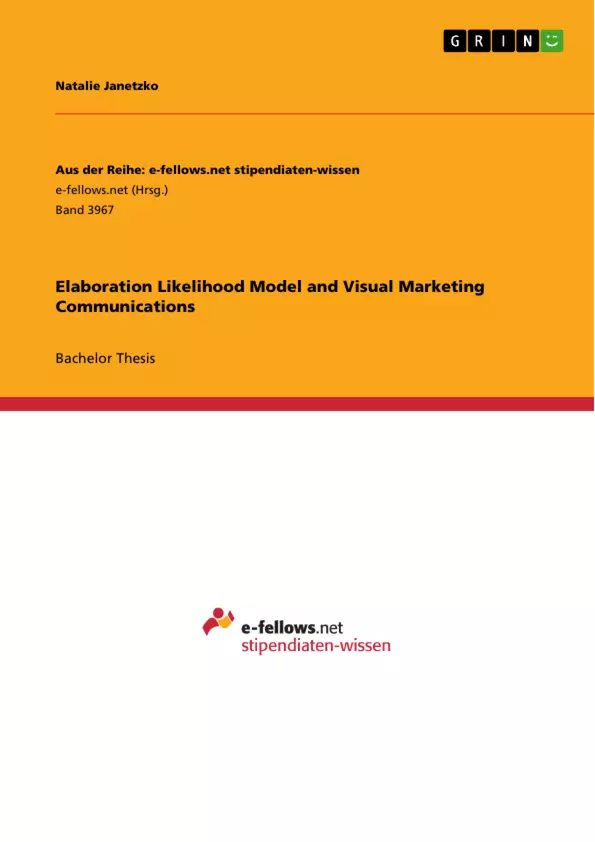Based on the Elaboration Likelihood Model this thesis aims at consolidating diverse research approaches to give an extensive outline of the various ways how visual elements – especially images - can influence a person’s attitude towards the issue of a marketing communication. They can be persuasive arguments communicating relevant information, serve as peripheral cues that cause affective responses, or influence the amount or direction of the cognitive processing of other elements in the marketing communication they are used in.
As a major part of marketing communications, visual elements have received extensive attention in marketing research. Many studies were conducted concerning their attitudinal impact on viewers, yet the majority only focuses on a limited range of their possible functions. Some concentrate on their ability to communicate product information, while others examine their ability to attract the viewer’s attention to other message components that yield relevant information.
Depending on its respective role in a persuasion process, a visual element can influence attitudes in various manners, and the resulting attitudes also differ in their persistence and behavioral impact. Therefore, it is crucial for marketing managers to understand the situational (e.g. distraction) and personal factors (e.g. need for cognition) as well as the properties of a visual element (e.g. issue-relevance) that cause it to assume one of these three roles on one occasion while assuming another in response to the next exposure.
Table of Contents
- 1 Abstract
- 2 Introduction
- 3 The Elaboration Likelihood Model of Persuasion
- 3.1 The ELM in General
- 3.2 The ELM applied to Visual Marketing Communications
- 4 Empirical Research on Visual Marketing Communications
- 4.1 Beauty and the Beholder: Toward an Integrative Model of Communication Source Effects
- 4.1.1 Purpose of Study
- 4.1.2 Methodology
- 4.1.3 Main Results and Conclusion
- 4.2 Picture-based Persuasion Processes and the Moderating Role of Involvement
- 4.2.1 Purpose of Study
- 4.2.2 Methodology
- 4.2.3 Main Results and Conclusion
- 4.3 Writing with Pictures: Toward an Unifying Theory of Consumer Response to Images
- 4.3.1 Purpose of Study
- 4.3.2 Methodology
- 4.3.3 Main Results and Conclusion
- 4.4 The Information Processing of Pictures in Print Advertisements
- 4.4.1 Purpose of Study
- 4.4.2 Methodology
- 4.4.3 Main Results and Conclusion
- 5 Implications for the Use of Visual Elements in Marketing Communications
- 5.1 Visual Elements as Persuasive Arguments
- 5.2 Visual Elements as Peripheral Cues
- 5.3 Visual Elements as Influencers of Cognitive Processing
- 5.4 Overview of Research Implications
- 6 Conclusion and Discussion
- 6.1 Implications for Marketing Communications
- 6.2 Unsolved Problems and Remaining Questions
- 6.3 Future Research
- References
Objectives and Key Themes
This bachelor thesis explores the impact of visual marketing communications on consumer persuasion through the lens of the Elaboration Likelihood Model (ELM). It aims to analyze existing research on visual elements in marketing communications and draw implications for practitioners.
- The Elaboration Likelihood Model (ELM) as a framework for understanding persuasion processes
- The role of visual elements in marketing communications
- Empirical findings on the effectiveness of visual marketing
- Implications for the use of visual elements in marketing strategies
- Future research directions in the field of visual marketing communications
Chapter Summaries
The thesis begins with an introduction to the topic and the ELM framework. It then dives into a review of existing empirical research on visual marketing communications, examining various studies that explore the effects of visual elements on consumer behavior. This analysis focuses on the methodologies employed, the main findings, and the implications drawn from each study. The work then delves into the implications of these findings for the practical application of visual elements in marketing communications, considering their use as persuasive arguments, peripheral cues, and influencers of cognitive processing. Finally, the thesis discusses future research directions in this field.
Keywords
The core concepts addressed in this thesis include the Elaboration Likelihood Model (ELM), visual marketing communications, consumer persuasion, visual elements, peripheral cues, cognitive processing, and research implications for practitioners.
- Quote paper
- Natalie Janetzko (Author), 2013, Elaboration Likelihood Model and Visual Marketing Communications, Munich, GRIN Verlag, https://www.grin.com/document/1130999



